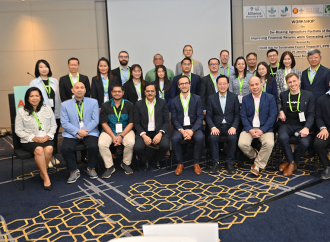FOR : APRACA CEO Policy Forum – Impact of the Global Financial Crisis on Regulators, Rural Financial Institutions / Microfinance Institutions, Urban-rural Partnership Stakeholders and Rural Clients in the Asia and Pacific Region BY : Thomas Elhaut, Director, Asia and Pacific, IFAD DATE : Seoul, Republic of Korea, 29 June 2009 An erratic sequence of
FOR : APRACA CEO Policy Forum – Impact of the Global Financial Crisis on Regulators, Rural Financial Institutions / Microfinance Institutions, Urban-rural Partnership Stakeholders and Rural Clients in the Asia and Pacific Region
BY : Thomas Elhaut, Director, Asia and Pacific, IFAD
DATE : Seoul, Republic of Korea, 29 June 2009
An erratic sequence of apparently-localised bank crises over the last decennium turned into a global systemic banking crisis in 2008, and escalated into a global financial storm, undermining in the process the critical credibility of financial sector protagonists. While the relationship is all but “simple”, the financial meltdown exacerbated the ensuing global recession. Indeed, the resulting credit crunch and risk averseness of financial actors of the last resort now deprive the real economy of investment resources to overcome the global economic still. Unemployment is rising, trade is slowing down, and poverty is increasing. This global economic crisis is not confined to an epicentre, and instead clearly demonstrates how deep securitisation and globalisation actual are; the velocity of the contagion is the best evidence that the assumed “de-linkage” is illusory. In the medium-term – the case is made – there is a need for a better financial regulatory system and effective stress-tested banking control. Money, especially hard-earned small-savings, is too important to be left unchecked in the visible hands of the financiers and the invisible hands of the markets.
In the short-run massive fiscal stimulus has to substitute to and then, subsidiarity again, complement financial intermediation – possibly crowding-out other priority uses of fiscal (and financial) resources, maybe some of them with higher safety net, welfare or poverty reduction outcomes. However, affirmative fiscal action further carries longer-term down-side risks of inflation, increased longer-term public sector debt, and a structurally increased cost of money – if it is not focussed on highly effective recession-busting investments, if it is not managed to switch from first rescue to subsequent investment priorities, and if not backed-up by carefully sequenced exit (and re-entry) strategies. Also, as a consequence of this all, volatility has become a permanent reality; and this affects resource poor countries, poor people and rural producers more than others. Risk transfer mechanisms and financial technology innovation to enable rural producers to cope with volatility are an essential part of the response to the new reality. Counter-cyclical fiscal management has become a complementary policy imperative.
In the mean time, the financial “recovery” operations and the global recession are masking the looming energy, other commodity and food crises. Once the recession ebbs away – as confidence returns, as production resumes and as domestic consumption, trade and investment take off – the harsh reality of the new resource (energy, land, water) and food equations that were problematic in 2008 will surge again. There is no consensus that a new system of higher price equations constitutes a permanent structural reality; but the factors that lead to the 2007-2008 soaring food prices remain part of global economic fundamentals – with population growth, the rate of income growth, changing consumer preferences, and the resulting food-fuel-feed requirements continuing to pose the challenge of a 100% increase in food production by 2050 (50% by 2030). Competition for increasingly scarce resources (land, water, commodities) also inflates their prices. Climate change and adaptation to climate change add significant risk and investment coefficients to the multiple-equation. While reliably high price structures send incentive signals to investing producers, the majority of rural producers swell the ranks of net buyers. The social cost of poorly-affordable food appears to exceed the benefits of, only-partially and inefficiently transmitted, more remunerative prices to producers.
The solution to this complex set of situations lies in a well sequenced and comprehensive framework of agricultural, fiscal and monetary policies and investments to: enhance resource-use efficiency in production to lower production costs; improve price transmission to producers (with better price transmission symmetry between input and output prices) to enhance the supply response and thus, over time, lower market prices of higher volumes of higher-value produce, while reducing volatility; increase profit margins for producers to stimulate further investment; and, in the interim, keeping prices affordable for net buyers. Optimising the use of SMART producer and consumer subsidies, to generate production incentives while dealing with the social costs of the new system of price equations, is part of this search for the policy grail; but price transmission to provide producer incentives must be part of the sustainability model. Alternative and renewable sources of energy, so important for agriculture, also. Internalising the investment implications of structural adaptation to the new system of price equations as well as to climate change will also be necessary. With an enabling policy framework rural investment is rational. Rural production may have become remunerative and even profitable. Debt management capabilities and capital accumulation are enhanced. The rural producers become viable and graduating clients for rural finance services providers.
However, today’s recession and financial crisis defer this aspiration to the time of recovery. In the mean time agriculture is not as profitable as it should be: production costs remain high, farm gate prices remain low, demand is temporarily depressed, returns on investments are low, credit is hard to obtain and/or expensive, and loan servicing is risk-affected. Banking on agriculture is risky, and capital today is costly – possibly disconnected from its opportunity cost – or not available from risk-averse asset holders. Financial intermediation is stifled as inflation-risks erode the value of savings. Risk perceptions lead to severe credit rationing. A “vicious circle”.
It is therefore imperative to initiate a “virtuous spiral” and jump-start the transition from recession to profitable rural economic livelihoods – the last-resort safety net for economies in transition. With the macroeconomic weight of agriculture and rural production in most developing countries, a mutually reinforcing fiscal and monetary policy to accelerate the resumption of growth in the rural economy, with agriculture, will be a key to economic recovery and the resumption of poverty reduction, as well as to coping with the resource-scarcity induced new price equation for commodities and food. It is imperative to increase productivity and profitability in the rural economy, modernise it (diversification and specialisation), commercialise it and make it more competitive; and this goes especially for the small farmers and the others actors in the agricultural value chains. Affordable (and remunerative) capital to underpin working capital with longer term investment capital is also required.
Rural finance can be a key trigger by fuelling higher-quality investment. Countries and rural finance institutions that had learned from the 1997 financial crisis in Asia appear to be in a pole-position. The banking systems have been less exposed to toxic assets; better financial regulation and banking control is limiting the contagion; and rural finance services providers are focussed and effectively offer innovative rural finance and risk transfer technologies to their small businesses clients. Rural banking is better affordable for clients, and remunerative for intermediation and for service providers. The cost of money and access to inclusive financial services is a major enabling condition. Affordability for the rural investors and real remuneration of capital must be met simultaneously. All this enables the rural sector of the economy to play its role of safety net for the modern sector of the economy, with its volatility and its limited capacity to absorb un-/semi-skilled labour, and to be a foundation for the virtuous spiral of economic recovery.
Clearly, financial innovation, the development of rural and micro-insurance, and stronger inclusiveness of rural and micro-finance systems, building further on the lessons learnt from 1997, are contributing answers to the recession and its poverty reduction set-back, as well as to the more volatile longer-term future. IFAD supports this agenda with its investment programme and its policy dialogue. Furthermore, the IFAD supported FinPower programme of APRACA also sees its relevance sharpened in for the current context, and needs to contribute effectively to this effort. APRACA members need to assume the pole-position, jump-start financial intermediation in a new economic context, be more aggressive in financial innovation with stronger inclusiveness, and share their experiences with innovations in agricultural finance, in micro-insurance and in other financial product innovations. This must also be accompanied by APRACA members’ actions to also enhance the quality of the policy environment, towards enhanced inclusiveness in a lasting manner, with less volatility.
Viable and adaptable rural finance systems are cornerstones for viable and adaptable rural economies; and continuous financial innovation with stronger inclusiveness will make measurable contributions to reaching the Millennium Development Goal of reducing poverty by half by 2015.















